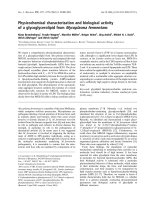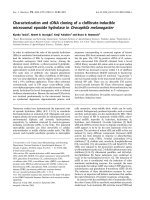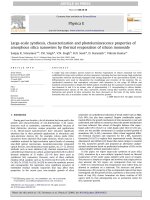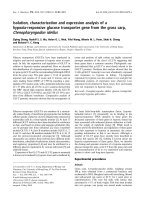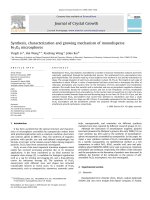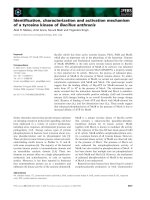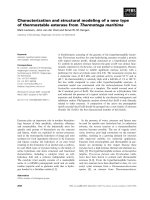Synthesis, characterization, and swelling behaviors of a pH-responsive CMC-g -poly(AA-co-AMPS) superabsorbent hydrogel
Bạn đang xem bản rút gọn của tài liệu. Xem và tải ngay bản đầy đủ của tài liệu tại đây (1.86 MB, 11 trang )
Turkish Journal of Chemistry
/>
Research Article
Turk J Chem
(2013) 37: 149 – 159
ă ITAK
c TUB
doi:10.3906/kim-1204-52
Synthesis, characterization, and swelling behaviors of a pH-responsive
CMC-g -poly(AA-co-AMPS) superabsorbent hydrogel
1
Yizhe WANG1,2 , Xiaoning SHI1,2 , Wenbo WANG1 , Aiqin WANG1,∗
Center of Eco-material and Green Chemistry, Lanzhou Institute of Chemical Physics,
Chinese Academy of Sciences, Lanzhou 730000, P. R. China
2
Graduate University of the Chinese Academy of Sciences,
Beijing 100049, P. R. China
Received: 20.04.2012
•
Accepted: 04.12.2012
•
Published Online: 24.01.2013
•
Printed: 25.02.2013
Abstract: New superabsorbent hydrogels were synthesized through free radical graft copolymerization of partially
neutralized acrylic acid (AA) and 2-acrylamido-2-methylpropanesulfonic acid (AMPS) onto carboxymethyl cellulose
(CMC) backbones. The structure and morphology of the synthesized superabsorbent hydrogels were characterized by
Fourier transform infrared spectroscopy and scanning electron microscope. The effect of the molar ratio of AMPS to AA,
the APS concentration, and the CMC content on swelling ratio was optimized. The swelling properties in various pH
solutions and saline solutions as well as the swelling kinetics were also evaluated. Results showed that the introduction
of AMPS enhanced the swelling capacity, swelling rate, and salt-resistance of the superabsorbent hydrogels. Moreover,
the hydrogels exhibited smart swelling behavior in multivalent salt solutions and better reversible pH sensitivity in the
pH 2.0 and 7.0 solutions, which makes the hydrogels available as a candidate for drug delivery systems.
Key words: Carboxymethyl cellulose, acrylic acid, 2-acrylamido-2-methylpropanesulfonic acid, superabsorbent hydrogel, pH-responsive
1. Introduction
Superabsorbent hydrogels (SAHs) are slightly crosslinked hydrophilic polymers with 3-dimensional network
structure and excellent water-absorbing and retaining properties even under some pressure. Due to their unique
advantages, SAHs are useful in various fields such as agriculture, 1,2 pharmaceuticals, 3,4 the food industry, 5
hygienic products, 6 and wastewater treatment. 7,8 In recent years, the natural polysaccharide-based materials
as potential substitutes for petroleum-based SAHs have received considerable interest because of their low
costs, abundance, and eco-friendly properties. 9,10 Many natural polysaccharides, including starch, 11−13 salep, 14
collagen, 15 cellulose, 16 sodium alginate, 17 chitosan, 18 and guar gum, 19,20 have been focused on and used to
prepare SAHs.
Carboxymethyl cellulose (CMC) is an anionic carboxymethyl ether of cellulose with tasteless, nontoxic,
and water-soluble characteristics, which render it suitable for potential applications in industrial fields as
a stabilizing, thickening, and bonding agent. 21 The polar carboxyl groups give CMC chemically reactive
and strongly hydrophilic characteristics, and so it shows promising application in superabsorbent fields. By
virtue of the abundant reactive -OH groups on the CMC chains, CMC can be easily modified through its
∗ Correspondence:
149
WANG et l./Turk J Chem
graft polymerization with hydrophilic vinyl monomers to derive new SAHs with improved properties. 22,23 2Acrylamido-2-methylpropanesulfonic acid (AMPS) has received great attention in the last few years due to its
strongly ionizable sulfonate group. As a good hydrophilic monomer, AMPS has usually been used to produce
SAHs. 24−27 In previous research work, 24 it was proven that the introduction of AMPS into the polymer
networks could increase the swelling ratio, pH sensitivity, and salt resistance of SAHs. Thus, it is expected
that the simultaneous introduction of CMC and AMPS can develop a new type of eco-friendly superabsorbent
hydrogels with improved structure and performance.
Based on above description, an attempt has been made to synthesize the pH-sensitive superabsorbent
hydrogel CMC-g -poly(AA-co-AMPS) by green aqueous solution polymerization. The effect of molar ratio of
AMPS to AA on the swelling properties of the superabsorbent hydrogels was investigated to find the optimum
synthesis conditions. The structure and morphologies of the superabsorbent hydrogels were characterized by
Fourier transform infrared (FTIR) spectroscopy and scanning electron microscope (SEM). The swelling kinetics,
pH, and saline-sensitive characteristics were also evaluated systematically.
2. Experimental
2.1. Materials
Sodium carboxymethyl cellulose (CMC, CP, 300–800 mPa · s (20 g/L, 20 ◦ C)) was purchased from Sinopharm
Chemical Reagent Co., Ltd, China. Acrylic acid (AA, chemically pure, Shanghai Shanpu Chemical Factory,
Shanghai, China) was distilled under reduced pressure before use. 2-Acrylamido-2-methylpropanesulfonic acid
(AMPS, chemically pure, Tokyo Chemical Industry Co., Ltd., Japan) was used as purchased. Ammonium persulfate (APS, analytical grade, Tianjin Chemical Reagent Co., Tianjin, China) and N, N -methylenebisacrylamide
(MBA, chemically pure, Shanghai Yuanfan Auxiliaries Co., Shanghai, China) were used as received. The other
reagents used were all of analytical grade, and all solutions were prepared with deionized water.
2.2. Preparation of CMC- g -poly(AA-co-AMPS) superabsorbent hydrogel
CMC (1.17 g) was dispersed in 30 mL of distilled water in a 250-mL 4-necked flask equipped with a mechanical
stirrer, a reflux condenser, a thermometer, and a nitrogen line. The reactor was immersed in an oil bath at
60 ◦ C and kept for 1 h under continuous nitrogen purging to remove the oxygen dissolved from the system.
APS (0.072 g, dissolved in 10 mL of distilled water) was then added to the slurry and the reaction mixture was
stirred continuously (250 rpm) at 60 ◦ C for 10 min. After 10 min, the reactants were cooled to 46 ◦ C, and the
desired amount of AA (preneutralized by NaOH solution), AMPS, and MBA was added. The total amounts of
AA and AMPS were 0.1 mol and the AMPS/AA molar ratios were 0/1, 1/70, 1/50, 1/30, and 1/10 (mol/mol).
Again, the oil bath was slowly heated to 70 ◦ C and maintained for 3 h to complete the polymerization. Finally,
the obtained gel products were dried in an oven at 70 ◦ C for 72 h. All of the samples were passed through
40–80 mesh sieve (180–380 µm) after being ground.
2.3. Measurement of equilibrium swelling ratio
The xerogel (0.050 g) (m1 ) was immersed in 250 mL of distilled water or 0.9 wt% NaCl solution at room
temperature for 3 h to reach swelling equilibrium. The swollen gels (m2 ) were separated from unabsorbed
water by filtering through a 100-mesh screen and then drained for 10 min. After weighing the swollen gels
( m2 ), the swelling ratio of the superabsorbent hydrogel (Qeq, g/g) was calculated using the following equation:
150
WANG et l./Turk J Chem
Qeq = (m2 − m1 )/m1
(1)
where m1 and m2 are the weights of the xerogel and the swollen gel, respectively. All procedures were carried
out 3 times repeatedly and the averages were reported in this study.
The method of measuring the swelling ratio in various pH and saline solutions was similar to that used
in distilled water.
2.4. Swelling kinetics measurement
Swelling kinetics of the superabsorbent hydrogels were measured in compliance with the following procedure:
0.05 g of xerogel was immersed in 250 mL of distilled water. At consecutive time intervals (1, 3, 5, 7, 10, 15,
20, 30, 60, and 120 min), the swollen gels were filtered out using a 100-mesh sieve and the swelling ratio of the
superabsorbent hydrogels at a given time t was measured according to the method described above.
2.5. Evaluation of pH responsivity
The solutions with pH 2–13 were prepared by diluting HCl (pH 1.0) and NaOH (pH 13.0) solutions. The
pH value of the solutions was determined by a pH meter (DELTA-320). The equilibrium swelling ratio in
different pH solutions was measured by a method similar to that in distilled water. The pH reversibility of the
superabsorbent hydrogel was investigated in terms of swelling and deswelling in 2 buffer solutions with pH 7.0
and 2.0, respectively. The consecutive time interval for each swelling–deswelling cycle was 40 min.
2.6. Characterization
FTIR spectra were determined with a Nicolet NEXUS FTIR spectrometer in the 4000-400 cm −1 wavelength
region using KBr pellets. The surface morphologies of the xerogels were examined using a JSM-6701F field
emission SEM (JEOL) after coating the xerogels with gold film.
3. Results and discussion
Crosslinking graft copolymerization of AA and AMPS onto CMC backbones was carried out using APS as a
radical initiator and MBA as a crosslinker. The persulfate initiator was decomposed under heating to produce
sulfate anion radicals, which extracted hydrogen from the hydroxyl groups of the CMC backbones to form
macromolecular radicals on the substrates. The vinyl groups of AA and AMPS were then reacted with the
active radicals to form covalent bonds and simultaneously generate the new radicals that can process the chain
propagation. In the presence of the crosslinking agent MBA, the end vinyl groups of MBA participated in the
polymerization and finally formed a 3-dimensional network of CMC-g -poly(AA-co-AMPS).
3.1. FTIR spectra analysis
The grafting polymerization was confirmed by comparing the FTIR spectra of CMC, CMC-g -PAA, and CMCg -poly(AA-co-AMPS). As shown in Figure 1, the strong characteristic absorption band of CMC at 1049 cm −1
(-OH groups) was obviously weakened after the reaction. This indicates that CMC participated in the grafting
copolymerization reaction through the -OH groups. 28 Meanwhile, the new bands at 1722 cm −1 (C = O stretching
vibration of -COOH groups), 1627 cm −1 (COO asymmetrical stretching vibration of -COO − groups), and 1455
and 1410 cm −1 (COO symmetrical stretching vibration of -COO − groups) in the spectrum of CMC- g -PAA
151
WANG et l./Turk J Chem
reveal that AA monomers were grafted onto the CMC chains. In addition, 1632 cm −1 (C = O stretching
vibration of -CONH groups) and 1192 cm −1 (stretching vibration of -SO 3 H groups) can be observed in the
spectrum of CMC- g -poly(AA-co-AMPS), which strongly suggests the existence of AMPS. Consequently, it is
concluded that the AA and AMPS monomers were successfully grafted onto the CMC backbones.
Figure 1. FTIR spectra of a) CMC, b) CMC- g -PAA, and c) CMC- g -poly(AA-co-AMPS) superabsorbent hydrogel.
3.2. Morphological analysis
Figure 2 shows the SEM images of CMC- g -PAA and CMC-g -poly(AA-co-AMPS) hydrogels with different
molar ratios of AMPS to AA. It can be seen that the CMC- g -PAA hydrogel (Figure 2a) exhibits a smooth and
tight surface whereas the CMC- g -poly(AA-co-AMPS) hydrogels (Figures 2b–2d) show an uneven and coarse
surface, which can be beneficial to the swelling properties. This difference is related to the different molar ratio
of AMPS to AA in the hydrogel, and the obvious coarse and microporous morphology can be observed in the
image of the CMC-g -poly(AA-co-AMPS) ( n (AMPS)/n (AA) = 1/50) superabsorbent hydrogel (Figure 2c).
The phenomenon can be explained by the fact that sulfonate groups can produce larger electrostatic repulsive
forces than carboxylate groups, and thus the porosity was increased with the increasing of the AMPS/AA
molar ratio. In addition, the alkyl group of AMPS is hydrophobic, which can form hydrophobic microdomains
to decrease the hydrogen bonding interaction between hydrophilic polymeric chains. 29 It could expand the size
of the network and the pores of the hydrogels are increased. However, excessive AMPS are not favorable to form
good 3-dimensional network because the long chain of AMPS can easily intertwine with CMC macromolecules
and increase the crosslinking of the hydrogels. Above all, the appropriate molar ratio of AA and AMPS could
regulate the network structure and change the surface morphology, which is convenient for the penetration of
water into the polymeric network.
3.3. Effect of APS concentration on the swelling ratio
Figure 3 illustrates the effect of APS concentration on the swelling ratio of the superabsorbent hydrogels in
distilled water and 0.9 wt% NaCl solution. As can be seen, the swelling ratio increased with increasing APS
concentration from 1.309 mmol/L to 6.545 mmol/L and then decreased considerably with a further increasing
in the amount of APS. When the APS concentration was lower than the optimal value, the number of active
radicals was increased with increasing APS concentration, which could efficiently improve the process of the
152
WANG et l./Turk J Chem
Figure 2. SEM images of a) CMC- g -PAA and b–d) CMC- g -poly(AA-co-AMPS) superabsorbent hydrogels with the
molar ratio of AMPS to AA of 1:70, 1:50, and 1:10, respectively.
chain transfer reaction and affect the growth of grafting polymer chains to form a regular 3-dimensional network.
Thus, the swelling ratio of the hydrogels was enhanced. However, when APS concentration was higher than
the optimal value, many more active radicals could accelerate the terminating step reaction via bimolecular
collision, which enhanced the crosslinking density. Thus, the swelling ratio of the hydrogel was decreased. The
optimum APS concentration in this study is 6.545 mmol/L.
3.4. Effect of CMC content on the swelling ratio
The effect of CMC content on the swelling ratio was investigated and is shown in Figure 4. With increasing
content of CMC, the swelling ratio of the hydrogel first increased and then decreased. The swelling ratio
enhanced with increasing CMC content until a maximum absorption (540 g/g in distilled water and 78 g/g in
0.9 wt% NaCl solution) was achieved at 15.96 wt% of CMC. As the CMC dosage was increased from 9.54 wt%
to 15.96 wt%, the macromolecular radicals that can be used to graft with monomers were increased and the
grafting efficiency was enhanced. As a result, the swelling ratio increased with increasing CMC content. Beyond
this content, the viscosity of the reaction system was increased and the chain transfer reaction was restricted,
which decreases the molecular weight of the graft polymer chains. Thus, the swelling ratio was decreased.
3.5. Effect of molar ratio of AMPS to AA on the swelling ratio
The effect of AMPS/AA molar ratio on the swelling ratio of the superabsorbent hydrogels was studied by
varying the AMPS/AA molar ratio from 0 to 0.1 (n (AA) +n (AMPS) = 0.1 mol), as shown in Figure 5. The
153
WANG et l./Turk J Chem
560
560
90
520
85
84
480
80
75
76
72
400
68
64
360
280
0
2
70
400
65
360
60
60
in distilled water
in 0.9 wt% NaCl solution
320
440
56
4
6
8
APS concentration (mmol/L)
52
10
in distilled water
in 0.9 wt% NaCl solution
320
280
Qeq (g/g)
440
80
480
Qeq (g/g)
520
Qeq (g/g)
Qeq (g/g)
88
8
10
12
14
16
18
20
55
22
24
50
CMC content (wt%)
Figure 3. Effect of APS concentration on the swelling
ratio of the superabsorbent hydrogels (CMC: 15.96 wt%,
Figure 4.
Effect of CMC content on the swelling
ratio of the superabsorbent hydrogels ((APS: 6.545
n (AMPS): n (AA) = 1:50).
mmol/L, n (AMPS): n (AA) = 1:50).
maximum swelling ratio (540 g/g in distilled water and 79 g/g in 0.9 wt% NaCl solution) was obtained at
n (AMPS)/n (AA) = 0.02. The increase in the swelling ratio with increasing molar ratio of AMPS/AA (from 0
to 0.02) can be attributed to the charge repulsion among sulfonate groups on the grafted poly(AMPS) chains,
which have better hydrophilicity than carboxylate groups. The subsequent decrease in swelling ratio of the
hydrogels can be ascribed to the low reactivity of the AMPS monomer. 30−32 This indicates that the monomer
grafting onto CMC chains decreases with increasing AMPS/AA molar ratio. In other words, the hydrophilic
monomers in the polymer chains are reduced, which leads to a decrease of the swelling ratio.
560
92
in distilled water
in 0.9 wt% NaCl solution
520
84
80
480
76
440
72
Qeq (g/g)
Qeq (g/g)
88
68
400
64
360
60
56
320
0.00
0.02
0.04
0.06
0.08
n(AMPS):n(AA) (mol/mol)
0.10
Figure 5. Effect of molar ratio of AMPS to AA on the swelling ratio (APS: 6.545 mmol/L, CMC: 15.96 wt%).
3.6. Swelling kinetics
To examine the influence of APS concentration and AMPS/AA molar ratio on the swelling kinetics, the profiles
of the swelling ratio in distilled water as a function of swelling time for the hydrogels are presented in Figures 6
and 7, respectively. It can be seen in Figures 6a and 6b that the swelling ratio of the superabsorbent hydrogels
was faster within 900 s. Later, the swelling ratio was reduced and the swelling curves became flatter. In this
154
WANG et l./Turk J Chem
section, the swelling kinetics can be described with Schott’s second-order swelling kinetic model: 33
t/Qt = A + Bt,
(2)
where Qt is the swelling ratio at time t; A is the reciprocal of the initial swelling rate, that is, A = 1/Kis ; and
B = 1/Q∞ (where Q∞ represents the theoretical equilibrium swelling ratio). On the basis of the experimental
data, t/Qt is plotted against time t to give an excellent straight line (Figures 6b and 7b) with good linear
correlation coefficient, indicating that the swelling of CMC-g -poly(AA-co-AMPS) follows the second-order
swelling kinetics. From the slope and intercept of lines shown in Figure 6b and Figure 7b, the values of the
initial swelling rate ( Kis ) and the linear correlation coefficient (R) can be calculated, and the results are listed
in the Table.
550
20
500
APS: 3.927 m mol/L
APS: 6.545 m mol/L
APS: 7.855 m mol/L
16
450
12
350
t/Qt
Qeq g/g)
400
300
APS: 3.927 m mol/L
APS: 6.545 m mol/L
APS: 7.855 m mol/L
250
200
8
4
150
0
100
0
(a)
0
1000 2000 3000 4000 5000 6000 7000
t (s)
(b)
1000 2000 3000 4000 5000 6000 7000 8000
t (s)
Figure 6. The a) swelling kinetic curves and b) swelling kinetic fitting curves of the superabsorbent hydrogels with
560
520
480
440
400
360
320
280
240
200
160
120
80
n(AMPS):n(AA) = 0:1
n(AMPS):n(AA) = 1:70
n(AMPS):n(AA) = 1:50
n(AMPS):n(AA) = 1:30
0
(a)
t/Qt
Qeq (g/g)
different concentrations of APS.
22
20
18
16
14
12
10
8
6
4
2
0
n(AMPS):n(AA) = 0:1
n(AMPS):n(AA) = 1:70
n(AMPS):n(AA) = 1:50
n(AMPS):n(AA) = 1:30
0
1000 2000 3000 4000 5000 6000 7000
t (s)
(b)
1000 2000 3000 4000 5000 6000 7000 8000
t (s)
Figure 7. The a) swelling kinetic curves and b) swelling kinetic fitting curves of the superabsorbent hydrogels with
different molar ratios of AMPS to AA.
155
WANG et l./Turk J Chem
Table. Swelling kinetics parameters for CMC- g -Poly(AA-co-AMPS) hydrogels.
Sample
APS: 3.927 mmol/L, n(AMPS):n(AA) = 1:50
APS: 6.545 mmol/L, n(AMPS):n(AA) = 1:50
APS: 7.855 mmol/L, n(AMPS):n(AA) = 1:50
APS: 6.545 mmol/L, n(AMPS):n(AA) = 0:1
APS: 6.545 mmol/L, n(AMPS):n(AA) = 1:70
APS: 6.545 mmol/L, n(AMPS):n(AA) = 1:30
Qeq (g/g)
465.6
539.0
386.4
385.6
455.8
423.8
Q∞ (g/g)
462.9
546.4
390.6
392.1
452.4
425.5
Kis (g/g/s )
8.9333
4.4812
8.1913
5.2306
6.6786
7.7501
R
0.9998
0.9996
0.9998
0.9999
0.9997
0.9997
Kis : initial swelling rate constant (g/g/s); R: linear correlation coefficient.
As can be seen from the Table, the APS concentration and molar ratio of AMPS to AA have obvious
influence on the swelling rate. For each sample, the initial swelling rate follows the order of: CMC- g poly(AA-co-AMPS) (APS, 3.927 mmol/L; n(AMPS):n(AA) = 1:50) >CMC- g -poly(AA-co-AMPS) (APS, 7.855
mmol/L; n(AMPS):n(AA) = 1:50) >CMC- g -poly(AA-co-AMPS) (APS, 6.545 mmol/L; n(AMPS):n(AA) =
1:30) >CMC- g -poly(AA-co-AMPS) (APS, 6.545 mmol/L; n(AMPS):n(AA) = 1:50) >CMC- g -PAA (APS,
6.545 mmol/L). Compared with CMC- g -PAA, the introduction of AMPS may enhance the swelling rate.
The significant enhancement of the swelling rate could be attributed to the simultaneous introduction of the
appropriate amount of AA and AMPS. The results are in accordance with the SEM observations that the
synergistic effect of AA and AMPS ameliorated the network and surface structure of superabsorbent hydrogels,
which is favorable to increase the diffusion and capillary action, and thus enhance the swelling ratio and swelling
rate. 34 In addition, the hydrophilicity of the superabsorbent was improved due to the polymerization of AMPS
monomer, which could also benefit the swelling rate. Consequently, the introduction of an appropriate amount
of AMPS contributes to improving the swelling properties of hydrogels compared with CMC- g -PAA hydrogel.
3.7. Effect of salt solution on the swelling behaviors
The effect of saline solution on the swelling behaviors of the optimized sample was measured in NaCl, MgCl 2 ,
and AlCl 3 solutions with different concentrations and the swelling curves are shown in Figure 8. As can be
seen, the swelling ratio of the hydrogels reduced with increased concentration of salt solutions. This swelling
fall is often attributed to the decrease of osmotic pressure between the gel network and external solution and
the enhancement of screening effect of counter ions. 35 The swelling ratio of the hydrogels in the saline solutions
is in the order of: Na + >Mg 2+ >Al 3+ . Different from monovalent cations, multivalent cations may link
with anionic hydrophilic groups to generate a strong surface ionic crosslinking, which can explain the sharper
decreasing tendency of the hydrogels in MgCl 2 and AlCl 3 solution than in NaCl solution.
3.8. Effect of pH on the swelling behaviors and pH responsive characteristics
The external pH solutions have remarkable influence on the swelling ratio of the hydrogels. As shown in
Figure 9, the swelling ratio of the CMC-g -poly(AA-co-AMPS) superabsorbent hydrogels increased sharply in
the pH 2–5 range and then decreased in the pH 10–13 range. In acidic medium (pH <5), the carboxylate and
sulfonate groups on the polymeric chain can turn into carboxylic acid and sulfonic acid groups. As a result, the
main anion–anion repulsive forces were eliminated, and the association among –COOH and –SO 3 H groups was
increased due to the hydrogen-bonding interaction. This increased the physical crosslinking degree and reduced
the swelling ratio. When the pH values are in the range of 5–10, some of the carboxylate and sulfonate groups
are ionized and the electrostatic repulsion between carboxylate and sulfonate groups causes an enhancement of
156
WANG et l./Turk J Chem
the swelling ratio In basic medium with higher pH value (>10), a charge screening effect of the counter ions
(Na + ) limits the swelling and leads to a decrease of the swelling ratio. Similar pH-dependent swelling behaviors
have been reported in the case of other hydrogel systems. 36
600
600
540
480
NaCl solution
420
MgCl2 solution
480
420
AlCl3 solution
360
Qeq (g/g)
Qeq (g/g)
540
300
360
300
n(AMPS):n(AA) = 0:1
240
240
180
180
120
120
n(AMPS):n(AA) = 1:30
60
60
n(AMPS):n(AA) = 1:10
n(AMPS):n(AA) = 1:70
n(AMPS):n(AA) = 1:50
0
0
0
5
10
15
Saline concentration (m mol/L)
2
20
4
6
8
10
12
14
pH
Figure 8. The equilibrium swelling of the optimized superabsorbent hydrogel in various concentrations of NaCl,
MgCl 2 , and AlCl 3 solutions.
Figure 9. Effect of external pH levels on the swelling
ratio of the superabsorbent hydrogels with different molar
ratios of AMPS to AA.
Since the hydrogels showed different swelling behaviors in acidic and basic pH solutions from the results
above, the reversible swelling–deswelling behavior of the optimized hydrogel was investigated in buffer solutions
with pH 2.0 and 7.0. As shown in Figure 10, the hydrogel exhibited a higher swelling ratio at pH 7.0 due to the
anion–anion repulsive electrostatic forces, whereas the swollen gel rapidly shrunk at pH 2.0 due to protonation
of the carboxylate and sulfonate anions. After 4 on–off cycles, the hydrogel still exhibited good sensitivity,
which renders the hydrogel promising for drug delivery application. 37
80
On
70
Qeq (g/g)
60
50
40
30
20
10
0
Off
0
20
40
60
80
pH
100
120
140
160
Figure 10. The pH responsivity for the optimized superabsorbent hydrogel.
157
WANG et l./Turk J Chem
4. Conclusions
For developing new types of eco-friendly superabsorbent hydrogel based on natural polysaccharides and reducing
the excessive consumption of petroleum resources, the novel superabsorbent CMC- g -poly(AA-co-AMPS) hydrogels were prepared by free-radical solution graft copolymerization. The FTIR spectra demonstrated that the
AA and AMPS monomers have been grafted onto CMC macromolecular backbones. SEM observations showed
the morphological changes of the superabsorbents with different AMPS/AA molar ratios, which is in keeping
with the swelling behaviors of the hydrogels. The effect of reaction parameters, such as AMPS/AA molar ratio,
APS concentration, and CMC content, were investigated. The maximum swelling ratio was achieved under the
optimum reaction conditions, which were found to be: AMPS/AA molar ratio = 1:50, APS = 6.545 mmol/L,
and CMC = 15.96 wt%. The introduction of AMPS obviously improved the swelling ratio, swelling rate, and
salt resistance of the hydrogels. Moreover, the hydrogels exhibited intriguing saline-responsive and pH-sensitive
characteristics. The excellent on–off switching swelling behaviors were also observed in various pH buffer solutions between pH 2.0 and 7.0. Above all, the superabsorbent hydrogel, based on renewable and biodegradable
natural CMC, showed improved swelling properties, salt-resistant properties, and smart pH responsivity, which
means it can be used as a potential candidate for drug delivery systems.
Acknowledgments
The authors gratefully acknowledge joint support of this research by the National Natural Science Foundation
of China (No. 51003112) and the Open Fund of the Key Laboratory of Chemistry of Northwestern Plant
Resources, China Academy of Sciences (No. CNPR2010kfkt01).
References
1. Liu, M. Z.; Liang, R.; Zhan, F. L.; Liu, Z.; Niu, A. Z. Polym. Int. 2007, 56, 729–737.
2. Guilherme, M. R.; Reis, A. V.; Paulino, A. T.; Moia, T. A.; Mattoso, L. H. C.; Tambourgi, E. B. J. Appl. Polym.
Sci. 2010, 117, 3146–3154.
3. Ngadaonye, J. I.; Cloonan, M. O.; Geever, L. M.; Higginbotham, C. L. J. Polym. Res. 2011, 18, 2307–2324.
4. Ismail, S. A.; Hegazy, E. A.; Shaker, N. O.; Badr, E. E.; Deghiedy, N. M. J. Macromol. Sci. A 2009, 46, 967–974.
5. Meena, R.; Prasad, K.; Siddhanta, A. K. Food Hydrocolloid. 2009, 23, 497–509.
6. Das, A.; Kothari, V. K.; Makhija, S.; Avyaya, K. J. Appl. Polym. Sci. 2008, 107, 1466–1470.
7. Paulino, A. T.; Guilherme, M. R.; Reis, A. V.; Campese, G. M.; Muniz, E. C.; Nozaki, J. J. Collid Interf. Sci.
2006, 301, 5562.
8. Kaásgă
oz, H.; Durmuás, A.; Kaásgă
oz, A. Polym. Adv. Technol. 2008, 19, 213220.
9. Zohuriaan-Mehr, M. J.; Kabiri, K. Iran. Polym. J. 2008, 17, 451–477.
10. Crini, G. Prog. Polym. Sci. 2005, 30, 38–70.
11. Li, A.; Zhang, J. P.; Wang, A. Q. Bioresource Technol. 2007, 98, 327–332.
12. Sadeghi, M.; Hosseinzadeh, H. Turk. J. Chem. 2008, 32, 375–388.
13. Zou, W.; Yu, L.; Liu, X. X.; Chen, L.; Zhang, X. Q.; Qiao, D. L.; Zhang, R. Z. Carbohydr. Polym. 2012, 87,
1583–1588.
14. Bardajee, G. R.; Pourjavadi, A.; Soleyman, R.; Ghavami, S. Adv. Polym. Technol. 2012, 31, 41–51.
15. Sadeghi, M.; Hosseinzadeh, H. Turk. J. Chem. 2010, 34, 739–752.
16. Ali, A. E.; Abd El-Rehim, H. A.; Kamal, H.; Hegazy, D. E. A. J. Macromol. Sci. A 2008, 45, 628–634.
158
WANG et l./Turk J Chem
17. Pourjavadi, A.; Barzegar, S.; Mahdavinia, G. R. Carbohydr. Polym. 2006, 66, 386–395.
18. Zhang, J. P.; Wang, Q.; Wang, A. Q. Carbohydr. Polym. 2007, 68, 367–374.
19. Shi, X. N.; Wang, W. B.; Wang, A. Q. J. Polym. Res. 2011, 18, 1705–1713.
20. Fujioka, R.; Tanaka, Y.; Yoshimura, T. J. Appl. Polym. Sci. 2009, 114, 612–616.
21. Borsa, J.; Racz, I. Cell. Chem. Technol. 1995, 29, 657–663.
22. Sadeghi, M.; Hosseinzadeh, H. J. Appl. Polym. Sci. 2008, 108, 1142–1151.
23. Pourjavadi, A.; Mahdavinia, G. R. J. Polym. Mater. 2005, 22, 235–243.
24. Pourjavadi, A.; Barzegar, S.; Zeidabadi, F. React. Funct. Polym. 2007, 67, 644–654.
25. Bao, Y.; Ma, J. Z.; Li, N. Carbohydr. Polym. 2011, 84, 76–82.
26. Kabiri, K.; Zohuriaan-Mehr, M. J.; Mirzadeh, H.; Kheirabadi, M. J. Polym. Res. 2010, 17, 203–212.
27. Ali, A. E. H.; El-Rehiem, H. A. A.; Hegazy, E. S. A.; Ghobashy, M. M. J. Macromol. Sci. A 2007, 44, 91–98.
28. Wang, W. B.; Wang, Q.; Wang, A. Q. Macromol. Res. 2011, 19, 57–65.
29. Wang, W. B.; Kang, Y. R.; Wang, A. Q. Sci. Technol. Adv. Mater. 2010, 11, 025006.
30. Pourjavadi, A.; Ghasemzadeh, H.; Mojahedi, F. J. Appl. Polym. Sci. 2009, 113, 3442–3449.
31. Abdel-Azim, A. A. A.; Farahat, M. S.; Atta, A. M.; Abdel-Fattah, A. A. Polym. Adv. Technol. 1998, 9, 282–289.
32. Marandi G. B.; Mandavinia G. R.; Ghafary S. J. Appl. Polym. Sci. 2011, 120, 1170–1179.
33. Schott, H. J. Macromol. Sci. B 1992, 31, 1–9.
34. Omidian, H.; Hashemi, S. A.; Sammes, P. G. Polymer 1999, 40, 1753–1761.
35. Buchanan, K. J.; Hird, B.; Letcher, T. M. Polym. Bull. 1986, 15, 325–332.
36. Zhai, N. H.; Wang, W. B.; Wang, A. Q. Polym. Compos. 2011, 32, 210–218.
37. Sadeghi, M. Turk. J. Chem. 2011, 35, 723–733.
159

